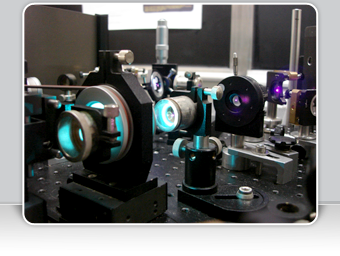« Back to all publications
Download this list in a RIS file or a BIB file or a PDF file
|
||||||||
The enthalpy of formation of the free ions generated by the electron transfer between benzophenone in the lower triplet state and 1,4-diazabicyclo[2,2,2]octane in acetonitrile has been measured using transient thermal phase grating. This enthalpy is smaller by more than 0.14±0.08 eV than the enthalpy of formation of the geminate ion pair obtained from a previous ps thermal phase grating investigation. Therefore, the dissociation of a geminate ion pair into free ions in endothermic. However, separation is exergonic if translational entropy in taken into account. A small and positive value of C, the correction term in the Rehm—Weller equation, is obtained if this term is considered as a free energy. The principles of the transient grating technique as a tool for investigating photoinduced processes in solution are briefly reviewed. | ||||||||
|
||||||||
The dynamics of the intermediate generated upon diffusional electron transfer (ET) quenching of 9,10-dicyanoanthracene by electron donors of varying oxidation potential in acetonitrile has been investigated using several transient grating techniques. With most of the donor/acceptor pairs studied, the transient grating spectrum cannot be differentiated from those of the free ions. Exciplex fluorescence, with the same lifetime as that of the ion pair, is observed with all donors. To extract from the measured kinetics the rate constant of exciplex dissociation, kEXdia , and of back ET, kEXBET , within these exciplexes, three different schemes have been considered. The best agreement is obtained by assuming that charge recombination predominantly takes place within the exciplex. The obtained kEXBET values are substantially different from the BET rate constants deduced indirectly from the free-ion yields and with a donor-independent rate constant of separation. For each class of donors, kEXBET exhibits a logarithmic free energy dependence with a slope of about −2 eV-1. Moreover, kEXdia is not constant but increases continuously with diminishing donor's oxidation potential. | ||||||||
|
||||||||
The competition between electron transfer (ET) and triplet energy transfer (TT) in the quenching of benzophenone, xanthone, and anthraquinone in the triplet state by molecules with both a sufficiently small oxidation potential and low triplet state was investigated in the picosecond to microsecond time scales. In the longer time scale, the product distribution depends strongly on the relative exergonicity of ET and TT processes, the yield of the lower energy product being at least four times larger than that of the other product. Picosecond transient grating measurements reveal that if TT is more exergonic than ET, the TT product is predominantly formed by two sequential ET reactions, i.e., by spin-allowed back ET within the triplet geminate ion pair formed upon ET quenching. However, if ET is more exergonic than TT, no conversion from the TT product to the ET product could be detected. In this case, the product distribution in the microsecond time scale seems to reflect the competition between the two processes. When both processes are exergonic, ET appeared to be always faster than TT. This is in agreement with the severe orbital overlap requirement for TT via the Dexter exchange mechanism. | ||||||||
|
Download this list in a RIS file or a BIB file or a PDF file
Contact:
Eric Vauthey
Physical Chemistry Department - Sciences II - University of Geneva
30, Quai Ernest Ansermet - CH-1211 Geneva 4 (Switzerland)
© All rights reserved by Eric Vauthey and the University of Geneva
Design and code by Guillaume Duvanel




